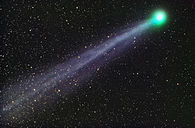galaxy and larger
The universe can be viewed as having a hierarchical structure. At the largest scales, the fundamental component of assembly is the galaxy . Galaxies are organized into groups and clusters , often within larger superclusters, that are strung along great filaments between nearly empty voids , forming a web that spans the observable universe.
Galaxies have a variety of morphologies, with irregular, elliptical and disk-like shapes, depending on their formation and evolutionary histories, including
interaction with other galaxies, which may lead to a merger . Disc galaxies encompass lenticular and spiral galaxies with features, such as spiral arms and a distinct halo . At the core, most galaxies have a supermassive black hole , which may result in an active galactic nucleus. Galaxies can also have satellites in the form of dwarf galaxies and globular clusters .
Within a galaxy
The constituents of a galaxy are formed out of gaseous matter that assembles through gravitational self-attraction in a hierarchical manner. At this level, the resulting fundamental components are the stars, which are typically assembled in clusters from the various condensing nebulae.  The great variety of stellar forms are determined almost entirely by the mass, composition and evolutionary state of these stars. Stars may be found in multi-star systems that orbit about each other in a hierarchical organization. A planetary system and various minor objects such as asteroids, comets and debris, can form in a hierarchical process of accretion from the
The great variety of stellar forms are determined almost entirely by the mass, composition and evolutionary state of these stars. Stars may be found in multi-star systems that orbit about each other in a hierarchical organization. A planetary system and various minor objects such as asteroids, comets and debris, can form in a hierarchical process of accretion from the
protoplanetary disks that surrounds newly formed stars.
The various distinctive types of stars are shown by the Hertzsprung–Russell diagram (H–R diagram)—a plot of absolute stellar luminosity versus surface temperature. Each star follows an evolutionary track across this diagram. If this track takes the star through a region containing an intrinsic variable type, then its physical properties can cause it to become a variable star. An example of this is the instability strip , a region of the H-R diagram that includes Delta Scuti, RR Lyrae and
Cepheid variables. Depending on the initial mass of the star and the presence or absence of a companion, a star may spend the last part of its life as a
compact object; either a white dwarf ,
neutron star , or black hole.
Hi! I am a robot. I just upvoted you! I found similar content that readers might be interested in:
https://en.wikipedia.org/wiki/Astronomical_object